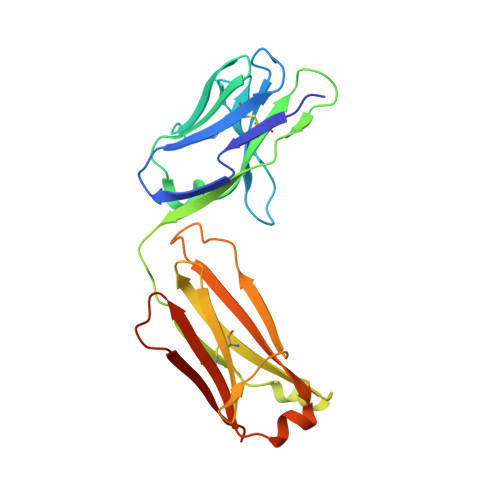Antibodies targeting the shared cytokine receptor IL-1 receptor accessory protein invoke distinct mechanisms to block all cytokine signaling.
Fields, J.K., Gyllenback, E.J., Bogacz, M., Obi, J., Birkedal, G.S., Sjostrom, K., Maravillas, K., Gronberg, C., Rattik, S., Kihn, K., Flowers, M., Smith, A.K., Hansen, N., Fioretos, T., Huyhn, C., Liberg, D., Deredge, D., Sundberg, E.J.(2024) Cell Rep 43: 114099-114099
- PubMed: 38636519
- DOI: https://doi.org/10.1016/j.celrep.2024.114099
- Primary Citation of Related Structures:
8VFU - PubMed Abstract:
Interleukin-1 (IL-1)-family cytokines are potent modulators of inflammation, coordinating a vast array of immunological responses across innate and adaptive immune systems. Dysregulated IL-1-family cytokine signaling, however, is involved in a multitude of adverse health effects, such as chronic inflammatory conditions, autoimmune diseases, and cancer. Within the IL-1 family of cytokines, six-IL-1α, IL-1β, IL-33, IL-36α, IL-36β, and IL-36γ-require the IL-1 receptor accessory protein (IL-1RAcP) as their shared co-receptor. Common features of cytokine signaling include redundancy of signaling pathways, sharing of cytokines and receptors, pleiotropy of the cytokines themselves, and multifaceted immune responses. Accordingly, targeting multiple cytokines simultaneously is an emerging therapeutic strategy and can provide advantages over targeting a single cytokine pathway. Here, we show that two monoclonal antibodies, CAN10 and 3G5, which target IL-1RAcP for broad blockade of all associated cytokines, do so through distinct mechanisms and provide therapeutic opportunities for the treatment of inflammatory diseases.
- Department of Biochemistry, Emory University School of Medicine, Atlanta, GA 30322, USA; Department of Pharmaceutical Sciences, University of Maryland School of Pharmacy, Baltimore, MD 21201, USA.
Organizational Affiliation:

















